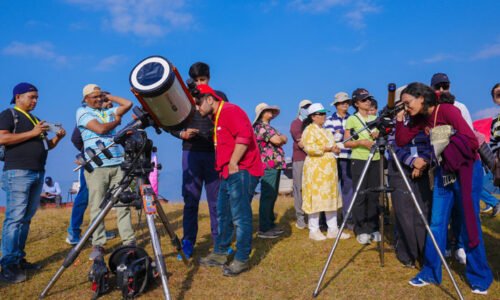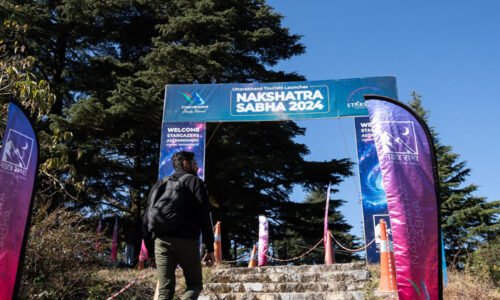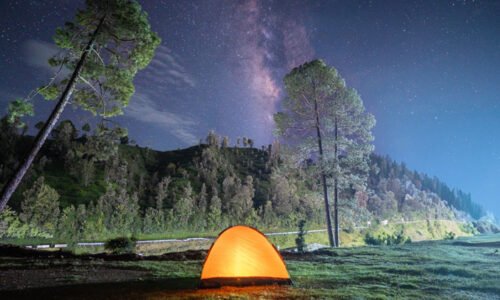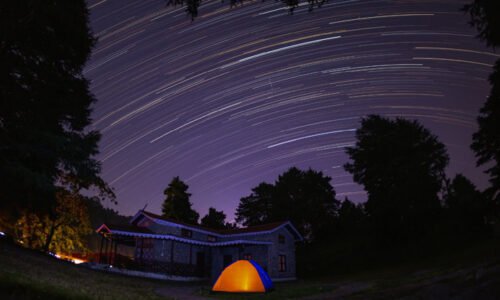No products in the cart.
Nakshatra Sabha in Uttarakhand: How Stargazing is Breathing New Life into Rural India
Uttarakhand’s Nakshatra Sabha is turning heads with sold-out events and a stellar campaign — pioneering astro-tourism while breathing life back into ghost villages.
By Sangeeta Srivastava
In a landmark initiative by the Uttarakhand Tourism Development Board in partnership with Starscapes, Nakshatra Sabha brought India’s pristine night skies to the center of tourism. Over the past year, this celestial campaign drew astrophiles across the length and breadth of India including some from as far as Norway, France, USA, Middle East — tourists, schoolchildren, scientists, influencers, and even locals who had never seen Saturn’s rings or the craters on the Moon before.
The result? A groundswell of interest in stargazing, citizen science, and rural discovery — all rolled into a dynamic, inclusive tourism experience.
A New Kind of Gathering
Spread across seven destinations — including Mussoorie, Jageshwar, Takula at Nainital ,Kartikswamy temple at Rudraprayag, Benital in Chamoli , Corbett and
Pithoragarh— each edition of Nakshatra Sabha blended the magic of stargazing with storytelling, science, and local heritage.
These weren’t passive events. They were immersive evenings packed with telescope viewings, mythological sky tours, astrophotography workshops, solar observations, and discussions on the importance of dark sky conservation.
“I saw Jupiter’s moons with my own eyes — I never thought something like this would happen in our little village,” said Rohit Arya, a participant at the Mussoorie Nakshatra Sabha.
“Astro-tourism is the future — it’s clean, educational, and transformational,” said Shivani Ahlawat, an amateur astronomer who travelled from Delhi to attend the Jageshwar session.
“Nakshatra Sabha is a one-of-a-kind starry experience curated by Starscapes—an initiative we at Magucho were truly thrilled to be a part of,” said acclaimed actress and former Miss India, Gul Panag.
“Nakshatra Sabha has ignited public imagination. It’s rare to find an initiative that combines science communication, heritage, and eco-tourism so effectively,” said Dr. Dorje Angchuk, engineer at the Indian Astronomical Observatory and a known voice for astronomy outreach.
The events also featured interactive storytelling sessions on celestial myths and local cosmology, tying ancient narratives to modern science. Night photography sessions,
planetarium simulations, and sunspot viewing through hydrogen-alpha filters added layers of experience.
Photos of long queues behind telescopes, children pointing skyward, and constellations captured in real time flooded Instagram, with content from @starscapes.experiences reaching over 3 million impressions across events.
Starscapes also ran curated workshops with school groups, providing basic astronomy education and telescope handling skills to students and teachers alike.
A Blueprint for Niche Tourism
More than a tourism event, Nakshatra Sabha is a proof of concept. It positions Uttarakhand not just as a destination of rivers and treks, but of dark skies and deep experiences.
“This initiative has helped develop a new vertical – niche, sustainable tourism centered around astronomy. It’s immersive, low-impact, and uniquely Uttarakhand,” said a spokesperson from the Uttarakhand Tourism Board.
At every location, the Sabhas collaborated with local homestays, artisans, and eco – guides generating income and awareness in communities often left out of mainstream tourism circuits. The events also drew support from district officials, forest departments, and citizen science communities.
The initiative even led to an uptick in Google searches for “stargazing in India” and “dark sky tourism” — a term that saw a 70% rise in search interest over six months, with Uttarakhand featuring in top results.
“It’s not just about promoting tourism, it’s about reclaiming the night sky as a shared cultural space,” said Dr. Aniket Sule, astrophysicist and educator at HBCSE-
TIFR. “Nakshatra Sabha shows what is possible when science meets local culture.”
From Ghost Villages to Guiding Stars
Now, the campaign takes an even more ambitious turn.
The next phase of Nakshatra Sabha will focus on “ghost villages” — abandoned or near- abandoned rural settlements in Uttarakhand, often emptied due to migration, lack of livelihood, or fading connectivity. These villages, however, share a rare gift: pristine, light-pollution-free skies.
Uttarakhand is preparing to identify and designate some of these as official Dark Sky Villages, blending astro-tourism with rural revival.
“We see this as a double-impact opportunity — preserving the night sky while breathing life back into our forgotten villages,” said Ramashish Ray, Founder of Starscapes. “It’s not about just looking at stars — it’s about building futures around them.”
In these locations, infrastructure will remain minimal by design — focused on dark-sky compliance, small-scale observatories, and skilling of local youth as astro-guides and storytellers. The vision is to turn ghost villages into guiding stars of India’s tourism narrative.
“This is rural tourism reimagined,” said Kamakshi Mahale, expert with the Rural Tourism Council. “The night sky becomes both a canvas and a livelihood.”
“From folklore to futures, dark skies can tell many stories — and bring people back to forgotten places,”added Dr. Shylaja, emphasizing the educational potential in these spaces.
The pilot designations for dark sky villages are expected to launch by late 2025, with support from astrophysical institutions and tourism researchers.
What the Sky Taught Us
In many ways, Nakshatra Sabha is a reminder: in our race to develop, we often forget to look up. But this campaign — powered by passionate astronomers, government support, and public imagination — has reminded thousands of that cosmic connection.
The Dark Sky Conservation Report released earlier this year at the Nakshatra Sabha Dark Sky Conclave showcases not only participation metrics but also a roadmap for preserving India’s skies before they are lost to light pollution.
From developing dark-sky policies to engaging with international bodies like IDA (International Dark Sky Association), Uttarakhand is poised to become India’s dark sky capital — with Nakshatra Sabha as its glowing beacon.
“It’s time India leads in experiential, purpose-driven tourism. Nakshatra Sabha isn’t just a campaign — it’s a movement,” said Shri Sachin Kurve, Secretary Tourism; summing up the sentiment shared by both policymakers and participants.






















